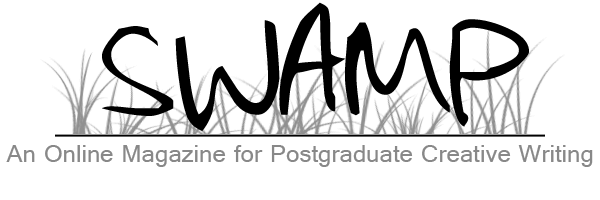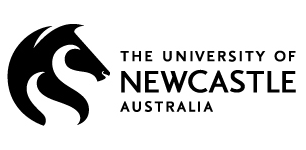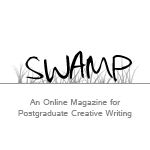Death of a Dentist
Stephen Childress (University of Missouri, USA)
.
.
Seybreh Callum barged into the picture frame shop and unrolled an enormous Rauschenberg print across the table. The image was of the artist on roller-skates with a huge umbrella strapped to his back—a modern Icarus.
“I’m thinking a Plexiglas box,” she stated.
I quoted her a rough estimate. She raised her eyebrows then laughed.
“Is Vernon upstairs?”
“It’s his day off.”
“All right, go ahead with the Plexiglas. I’ll call him tomorrow.”
She squeezed past the counter, catching her lamb coat. When I gently freed it her full lips parted briefly to reveal sturdy incisors.
A week later, I delivered the framed print. The maid met me and held the door while I labored in the large carton.
“I’ve cleared a space,” Seybreh said and led me through the rooms.
After graduating from art school, I had worked in the City Art Museum. Now, trailing Seybreh over the parquetry, I surveyed the amount of artwork covering the walls—enough to start a small museum.
After I carefully hung the lithograph, Seybreh gave me a short tour of their estate, which spread down a long hill and along a creek through woods. Climbing back up to the patio, we met her husband Angus. Whereas Seybreh sprang from Texas oil money, Angus’ parents were peasant immigrants from Ireland, the father dying soon after arrival. Angus put himself through college and become an esteemed oral surgeon. Seybreh often said she had given up pharmacology in order to raise their four children, yet I felt no presence of them. Angus led me to an expansive wall of glass and pointed out his landscaping; proud of his horticultural skills, he talked expertly of plants. The visit ended with him inviting me and my wife to dinner.
I was flooded with work, the frame shop’s owner being on vacation, and forgot Callum’s invitation. Seybreh unceremoniously called the morning of the dinner to remind me. “Don’t worry about bringing anything,” she laughed—a little sarcastically I thought—and hung up.
When I and my wife, Carole, arrived at the Callum’s, I self-consciously parked our rusted van at the far end of the driveway. The maid directed us to the living room, where, in the sea of sofas, we tipped like buoys to the tug of conversation. Two bottles of wine later, we were seated for dinner, Seybreh placing me facing the roller-skating Rauschenberg. Angus was becoming churlish, his efforts to taunt me into rebuttals of his pronouncements on art having failed. I slipped away from Angus by directing him toward Carole, which, in turn, allowed her to escape Seybreh’s inquisition. I soon discovered that most of the art in the house was Seybreh’s. Angus was frustrated because the older established artists were beyond his reach. Seybreh was semi-content because her appetite for purchasing art frequently included the artist. The Callums regularly, publicly, inflicted wounds on each other. Were house guests, I reflected, invited simply to provide a new venue for verbal gunslinging?
The eroding after-dinner exchange proved a waste of the aromatic fire in the living room. Though it was a chilly October evening, I was not sorry to abandon the warmth radiating from the apple logs. My wife and I left the Callum house feeling we had just auditioned badly for a play whose roles we had no intention of filling.
My relation with Vernon, the picture frame shop owner, was souring and, before Christmas, I left to become manager of his competitor’s, in a wealthy northern suburb. Less than a month later, during a relaxed lunch in a nearby Croatian restaurant, a large shadow fell across the small, checkered tablecloth.
“Something happen between you and Vernon?” It was Seybreh.
I stood up, losing my napkin. “Sit down and have a drink.” A cane chair disappeared under her.
“What would you suggest?” she drawled, smothering her place mat as she leaned toward me. It sent me into a flashback of the night she had surprised me while I was working late in the second-floor studio of Vernon’s shop. Vernon had absent-mindedly left the front door unlocked, again, and she had come upstairs, surveyed the room, walked to the hay bale next to my work bench and straddled it. Then, in one movement, she pulled off her cashmere sweater and handed it to me.
The flashback ended abruptly when Seybreh leaned back, releasing the tiny restaurant table. It wobbled on its post. “Vernon’s wife just left him,” Seybreh announced. “She got the house and he moved into the second floor of the shop.” She peered at me, trying to gauge the words’ effect.
“The last time I saw Vernon he was sitting alone in a coffee shop,” I replied. “I remember I’d never seen him so forlorn.”
She picked up my wine glass and sniffed it.
“All they have is house wine,” I said.
She ordered a Czech beer. “It wouldn’t hurt for you to stop by occasionally.”
We exchanged glances.
“Anyway,” she smiled, “Angus was wondering if you could help in planting a large tree this weekend, if you have time.” Seybreh drained her beer and continued to talk. I watched Mirla, the owner, stirring a large pot. Suddenly Seybreh stopped.
“I’ll call Angus tonight,” I said hurriedly.
Seybreh thrust some bills on the table and, squeezing through the opening between my chair and the wall, brushed her breasts against my head. “You’re so accommodating,” she said, and left. Mirla put up the CLOSED sign and sat next to me with a bottle of Smederevka. “Who was that?” she asked.
The next Sunday, as I drew up to the Callum house, I saw Angus forking leaves into a compost heap. A lacy yew tree, its roots balled in burlap, sat in his pickup truck. Angus, although twenty years older than I, bounced toward me and clinched my calloused hand. Surprised that a dentist’s hands were not soft, I matched his grip.
“I’ve chosen a spot near the bend there,” Angus said, pointing to the creek, then got in the truck. As I started down the hill, I noticed Seybreh open the patio doors and sit down with a drink.
Angus backed the truck slowly to the hole’s edge. We maneuvered the yew onto some planks, carefully guided it into place as its weight carried it down, then we righted it, and turned it so its fuller branches displayed to the house. Tearing off the burlap, filling in, and watering took the better part of an hour, and we had to take off our jackets in the warm Indian summer.
“Hungry?” Angus asked.
“I could eat the tree.”
“I think we can do better than that.” And he led me up to the kitchen. After brunch, Angus drove the truck back up the hill and motioned me over. “Could I possibly visit your studio sometime?” Then added quickly, “If it’s not an imposition.”
We drove to my house, and when I led Angus into my studio, I was relieved that he was not a flatterer. Whereas he provoked discussions with me about art, because he wanted to shadow box with an artist, he was quietly complementary when viewing my work. Later, I wondered if he had genuinely liked my sculpture or had been polite in deference to someone he wanted as a friend.
“I really like that piece in walnut and straw by the wall, there, that you showed me when we first came in.”
“The ‘Crucifix’.”
“Yes.”
“It’s been accepted for the up-coming exhibition at the museum.”
“Well, after the exhibition, if you have no other plans for it, I’d like to buy it.”
Angus walked over to the sculpture and ran his hand over the planed walnut. “I can see the wood bleaching under the weather, the straw gradually disappearing—it is like a person’s body disintegrating.” He paused. “It will be perfect on that little rise before the woods.” He turned, “Callum’s Calvary!” he said, and laughed.
Thunder boomed and rumbled as we left the barn. Angus yelled, “’There goes the potato wagon!’—my Scottish grandmother used to say,” and jumped into the truck. Raindrops dotted the windshield like a pointillist painting.
Angus came by late one evening several weeks later, his face a map of fatigue.
“Mind if I sit down?”
I motioned to the room; there were no chairs.
Angus half-collapsed in a deep bed of shavings. He pulled an earthenware bottle of whiskey from his overcoat and fumbled with the cork. “I’ve been sav—saving this.” Over the next half hour we passed the bottle back and forth, Angus growing increasingly morbid.
“Your shoes are shot to hell,” he said, spilling some whiskey.
“What’s eating you?” I asked. “I’ve never seen you like this before.”
“Fucking—” and he toppled over in a stupor.
I slipped the bottle from his hands and sipped whiskey amid the purr of the kerosene heater. When the fuel ran out I reluctantly corked the bottle, got Angus to his feet and slung him over my shoulder, then carried him to the house and laid him on the couch. I hesitated before calling Seybreh. I climbed the stairs with her remonstrations still in my ear.
Angus woke at dawn and walked to the studio. I found him sitting puffy-eyed, his moustache frosted.
“The kerosene ran out last night,” I said, grabbing an empty five-gallon can. “Aren’t you cold?”
Angus shook his head.
Once the heater was lighted, I turned to Angus. “I’m meeting a sawyer near the Kentucky border at around 10:00 this morning. We’re going to cull some large beech trees for a commission I have. I could use your company. We’d have to leave by 7:30.”
Angus wiped his defrosting moustache. “Can I use your phone? I’ll need to cancel some appointments.”
We tramped through dense woods with the sawyer, searching for beeches thick enough for my project. By 2:00 we had found and marked three and, together with the one the sawyer had cut a month before, had filled my quota; there was nothing left to do but go home and wait for the wet logs to slowly cure.
Sitting in the truck waiting for the weak heater to kick in, our breath fogged the glass. Angus had lost his enthusiasm—the shadow he had tried to drown the night before was reappearing. The windshield mostly cleared and I put the truck in gear. It rattled and bucked over the deep-rutted, frozen logging road, and we banged our knees on the dash until we reached the county road. As we wound past fields and small towns, Angus often rubbed his knees and repeated, “I never realized beeches grew that big.”
The next time I saw Angus was when he helped me remove the “Crucifix” from the museum grounds. We arrived late and, under the darkening sky, loaded it onto the bed of my half-ton truck. On the way to his house Angus urged me to stop somewhere and get a bottle. We found a liquor store and I went around the truck checking the ropes while he bought something to drink. After a few pulls of bourbon, we started to get in the truck and I noticed something fall out of Angus’ jeans. I walked over and picked up what looked like a wad of paper. It was a fold of crisp thousand-dollar bills in a gold clip. I counted twenty before Angus rolled down the window and asked if I needed any help.
“Not if this were mine,” I said and handed him the money.
“Where—?”
“It fell out of your pocket when you climbed in the cab,” I said.
He studied my face. “Some people would have kept it.” He took out one of the bills and handed it to me.
“Piss off,” I said and walked to the driver’s side. We started off again. “You always carry that much around?” I asked.
It was the holiday season and I had taken delivery of the beech logs. My wife and I had been invited to the Callum’s for a New Year’s party, but the days leading up to January were crammed with work and visits to other friends and relatives. I phoned Seybreh to say that I wasn’t sure if we could make it. She hung up.
Early the next morning, Angus showed up, unshaven. He handed me some lox and bagels. “Do you have any cream cheese?” Carole was sleeping off the partying from the night before and our daughter was thumbing through a cluster of new books.
“The last of the beech logs came,” I said.
We carried our coffee and bagels to the barn. Angus walked around the mammoth, squared-off timbers. “The biggest beech trees I’ve ever seen.” I chuckled, but he only looked at me blankly. Angus asked if I could go with him to his house and help cut firewood, but when outside, he got in the passenger seat and motioned for me to drive. When we pulled onto the interstate he said, “Could you just drive around a bit?”
I turned onto a country road and concentrated on maneuvering over the snow-covered gravel, once stopping to let an emaciated fox cross. Angus leaned inertly against the door. I noticed a half-empty bottle of whiskey on the floor. I put it in the glove compartment and drove home. When I pulled up to the house, Angus’ shoulders were slack, his eyes closed. I grew slightly alarmed. “Angus, you’d better come inside for awhile.”
His lips barely moved, “No, let me sit.”
“Well, I’ve got to take a leak.” I hurried behind the studio. When I came back, Angus had driven off.
Three weeks later, my wife stumbled upon Angus’ obituary.
“Do you think it was suicide?” Carole asked softly.
“I’m calling Seybreh. How could she let me find out about this from a newspaper?” I dialed and let the phone ring. “No answer. I’ll be back as soon as I can.”
In the ash-grey dusk, Callum’s low, minimalist house lay like a casket. I hesitated at the front door then rang the bell. A woman I’d never seen answered.
“Yes?” she said impatiently.
“Is Seybreh here?” I asked.
“Seybreh? Seybreh’s in Texas.”
“Texas? Do you know when she’ll be back?”
“She took her daughter there to live with her grandparents.”
“What about the other children?” I asked.
“The son is in a boarding school and the twins are staying with Angus’ sister in Boston.”
“I was a friend of his. Could you tell me—”
“Barbiturates. He was heavily addicted, apparently for years.” Her eyes searched mine. “Surely, if you were his friend, you knew that?” It seemed she was regarding me as if complicit in her brother’s death.
“Didn’t he leave a note or—”
“No, nothing. He was found in his car—in the creek.”
The sister made me feel such an interloper that I didn’t ask if I could walk down to see if the “Crucifix” were still there. Disoriented, I drove the streets. I stopped at the entrance to the garden of the theological seminary, where I had sometimes come to gather my thoughts. The iron gate was ajar and I went in. I sat, insensible to the thick snowfall. Flakes the size of beech shavings gradually created of me and the bench a unified apparition.
For three months I unsuccessfully tried to contact Seybreh. Then one day I decided to swing by the Callum house, and saw a For Sale sign. I walked around to the back. Slowly descending to the creek, I followed it to the hillock—my “Crucifix” was still there. A movement on the center post caught my eye, and when I moved closer saw that it was a plastic envelope nailed to the wood. Inside were photos of me and Angus with the sculpture. Tucked in back was a thousand-dollar bill.
The ground had thawed in patches, and I slipped as I turned to leave, sliding into the deep furrows dug by the tow-truck and Angus’ Mercedes. Chokeberries lay among the thrown up clods.
“Spring will come late this year,” I thought.
.
.
Stephen Childress: currently Arthur Mag Doctoral Fellow, Interdisciplinary Studies, UMKC, and writing biography of the assassinated president of Rwanda. MA creative writing, UMKC. BFA, Herron School of Art, I.U. Indiana Arts Commission Artist in Residence. Artist in Residence, Arts Acre, Kolkata, India. Represented in Eiteljorg Museum and private collections. Co-published poetry mag with Ronald Wray, Indpls. Two plays produced, one in Mumbai, one in Tokyo. Filmed two documentaries. Wrote/illustrated two children’s books. Write an online film review. Have lived and worked in Italy, France, UK, Japan and India. Currently living in Boston.






